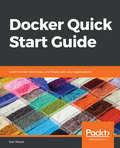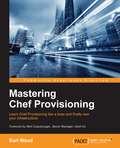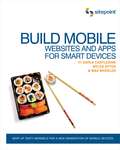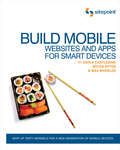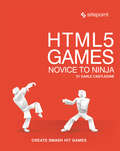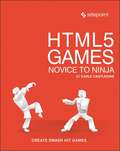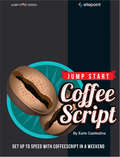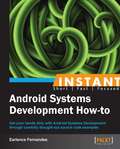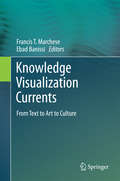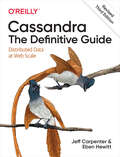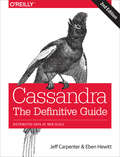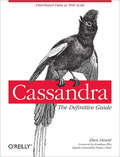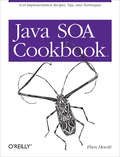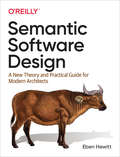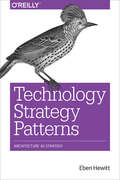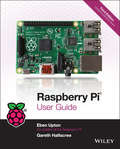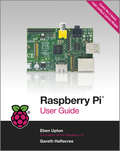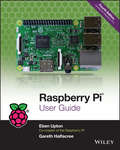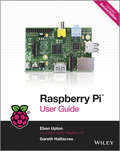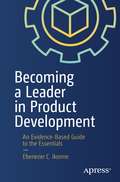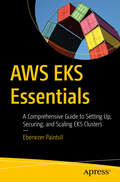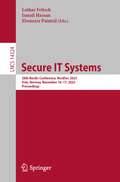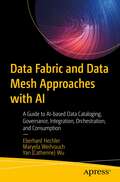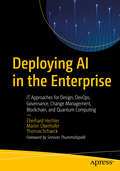- Table View
- List View
Docker Quick Start Guide: Learn Docker like a boss, and finally own your applications
by Earl WaudDevelop and build your Docker images and deploy your Docker containers securely.Key FeaturesLearn Docker installation on different types of OSGet started with developing Docker imagesUse Docker with your Jenkins CI/CD systemBook DescriptionDocker is an open source software platform that helps you with creating, deploying, and running your applications using containers. This book is your ideal introduction to Docker and containerization.You will learn how to set up a Docker development environment on a Linux, Mac, or Windows workstation, and learn your way around all the commands to run and manage your Docker images and containers.You will explore the Dockerfile and learn how to build your own enterprise-grade Docker images. Then you will learn about Docker networks, Docker swarm, and Docker volumes, and how to use these features with Docker stacks in order to define, deploy, and maintain highly-scalable, fault-tolerant multi-container applications.Finally, you will learn how to leverage Docker with Jenkins to automate the building of Docker images and the deployment of Docker containers. By the end of this book, you will be well prepared when it comes to using Docker for your next project.What you will learnSet up your Docker workstation on various platformsUtilize a number of Docker commands with parametersCreate Docker images using DockerfilesLearn how to create and use Docker volumesDeploy multi-node Docker swarm infrastructureCreate and use Docker local and remote networksDeploy multi-container applications that are HA and FTUse Jenkins to build and deploy Docker imagesWho this book is forThis guide is for anyone who needs to make a quick decision about using Docker for their next project. It is for developers who want to get started using Docker right away.
Mastering Chef Provisioning
by Earl WaudLearn Chef Provisioning like a boss and finally own your infrastructure About This Book * This is the first Chef book focused on provisioning infrastructure as its sole task. The book offers a clear solution to a specific pain point: learn to make your system work faster. * Learning better approaches to load balancing and parallelization with this book will save you time * By mastering the techniques in this book, you will know how to run an entire fleet of machines without breaking a sweat * This book is more helpful than the documentation ( https://docs.chef.io/provisioning.html), with a stronger guiding voice and clearer explanations and use cases Who This Book Is For This book is for Software Engineers, System Administrators, or DevOps Engineers who need to quickly deliver reliably consistent infrastructure at scale. You are expected to have intermediate experience with Chef and Ruby and will be reading this book to advance your knowledge and take your skillset to the next level. What You Will Learn * Use best practices to describe your entire infrastructure as code * Automate and document every aspect of your network, from the hardware of individual nodes to software, middleware, and all containers and clouds * Create a perfect model system * Make the best possible use of your resources and avoid redundancy * Deliver on the promise of Infrastructure as Code * Scale with ease by properly provisioning their infrastructure * Use the best Test Driven Development methodologies In Detail This book will show you the best practices to describe your entire infrastructure as code. With the help of this book you can expand your knowledge of Chef because and implement robust and scalable automation solutions. You can automate and document every aspect of your network, from the hardware to software, middleware, and all your containers. You will become familiar with the Chef's Chef Provisioning tool. You will be able to make a perfect model system where everything is represented as code beneath your fingertips. Make the best possible use of your resources, and deliver infrastructure as code, making it as versionable, testable and repeatable as application software Style and approach By dedicating a whole book solely to the question of provisioning, this book will teach administrators to use Chef as a birds-eye lens for their entire system. It will moves you away from the specifics of each machine and its automations and instead will teach you them how to approach the entire cluster as something different than the sum of its parts. By focusing on infrastructure as code as its own project, the book offers elegant, time-saving solutions for a perfectly described and automated network.
Build Mobile Websites and Apps for Smart Devices
by Earle Castledine Myles Eftos Max WheelerBuild Mobile Websites and Apps for Smart Devices is a practical guide for front-end web designers and developers. You'll discover a fun and fresh approach to mobile web design and development, with enormous scope for opportunity. Mobile web development is changing rapidly, with a greater emphasis on modern touch-screen smartphones. By following the advice in this book, you can be sure you're learning the skills youneed to make the most of this new technology. You'll learn how to: Design effective interfaces for modern devices Use HTML5 and CSS3 to build fast, responsive layouts that look great on every device Use JavaScript to create a native feel with transitions, touch and swipe events, animations, and more Introduces PhoneGap and shows readers how to add native functionally to their web app with ease Leverage APIs to take advantage of built-in device functionality Use PhoneGap to turn your web app into a native app for iOS, Android, BlackBerry, and other platforms-and sell it online And lots more. . .
Build Mobile Websites and Apps for Smart Devices: Whip Up Tasty Morsels for a New Generation of Mobile Devices
by Earle Castledine Myles Eftos Max WheelerBuild Mobile Websites and Apps for Smart Devices is a practical guide for front-end web designers and developers. You’ll discover a fun and fresh approach to mobile web design and development, with enormous scope for opportunity.Mobile web development is changing rapidly, with a greater emphasis on modern touch-screen smartphones. By following the advice in this book, you can be sure you’re learning the skills youneed to make the most of this new technology.You’ll learn how to:Design effective interfaces for modern devicesUse HTML5 and CSS3 to build fast, responsive layouts that look great on every device Use JavaScript to create a native feel with transitions, touch and swipe events, animations, and moreIntroduces PhoneGap and shows readers how to add native functionally to their web app with easeLeverage APIs to take advantage of built-in device functionalityUse PhoneGap to turn your web app into a native app for iOS, Android, BlackBerry, and other platforms—and sell it online And lots more...
HTML5 Games: Create Smash Hit Games in HTML5
by Earle CastledineThis book will teach you how to create awesome video games. Games from scratch. Games that run cross-platform, in web browsers, and on phones. Games filled with dynamic sound and music. Games overflowing with impressive visual effects. Fun games. More importantly, this book will teach you how to think about making games. You'll learn to analyze and dissect games; to understand what it is that makes great games great. By the end of the journey you'll have all the knowledge and tools needed to produce engaging, polished products that people will love to play. What's inside? Learn the basics: game loops and inputDraw graphics on the screen using CanvasAdd amazing sound effects and music using the Web Audio APIDevelop several fun games: a platformer, a shoot ‘em up, a dungeon crawler, and a physics-based gameCreate your own JavaScript game libraryJazz up your game up with "juice": screen shakes, particle effects, and more
HTML5 Games: Novice to Ninja
by Earle Castledine<p>This book will teach you how to create awesome video games. Games from scratch. Games that run cross-platform, in web browsers, and on phones. Games filled with dynamic sound and music. Games overflowing with impressive visual effects. Fun games. <p>More importantly, this book will teach you how to think about making games. You'll learn to analyze and dissect games; to understand what it is that makes great games great. By the end of the journey you'll have all the knowledge and tools needed to produce engaging, polished products that people will love to play. <p>What's inside? <p> <li>Learn the basics: game loops and input <li>Draw graphics on the screen using Canvas <li>Add amazing sound effects and music using the Web Audio API <li>Develop several fun games: a platformer, a shoot em up, a dungeon crawler, and a physics-based game <li>Create your own JavaScript game library <li>Jazz up your game up with "juice": screen shakes, particle effects, and more</li> </p>
Jump Start CoffeeScript: Get Up to Speed With CoffeeScript in a Weekend
by Earle CastledineA practical and concise introduction to CoffeeScript, a programming language that compiles into JavaScript and that makes working with JavaScript easier. The book lays out the basics of the language, its syntax, and the interesting features that set it apart from JavaScript. It should satisfy anyone with an intermediate level of understanding of JavaScript who needs a conceptual and practical introduction to CoffeeScript.The book is based around a practical project, leading you through the building of a simple HTML-based 2D game, and explaining the language's philosophy, syntax, and features step-by-step along the way. You'll be able to see results on-screen from the very beginning, starting with a simple JavaScript drawing function transformed into CoffeeScript. The game's code is based on well- understood principles and prior art, using common, simple programming patterns that are easy to grasp while also demonstrating CoffeeScript's expressiveness.This is a fun and fast-paced book that rewards you for each completed step with interesting game features. You will finish the book with the sense of accomplishment that comes from building something fun, as well as having gained a solid understanding of CoffeeScript and an interest in exploring its more advanced features.
Instant Android Systems Development How-to
by Earlence FernandesFilled with practical, step-by-step instructions and clear explanations for the most important and useful tasks.This is a how-to book with practical, coded examples which are well explained.This book is for seasoned Android SDK programmers. Knowledge of Java, Linux, and C is assumed. Certain Operating System concepts like processes, threads, shared memory, and inter process communication is also assumed, but the book provides necessary background before any obscure topics are introduced.
Knowledge Visualization Currents
by Francis T. Marchese Ebad BanissiThis text reviews the evolution of the field of visualization, providing innovative examples from various disciplines, highlighting the important role that visualization plays in extracting and organizing the concepts found in complex data. Features: presents a thorough introduction to the discipline of knowledge visualization, its current state of affairs and possible future developments; examines how tables have been used for information visualization in historical textual documents; discusses the application of visualization techniques for knowledge transfer in business relationships, and for the linguistic exploration and analysis of sensory descriptions; investigates the use of visualization to understand orchestral music scores, the optical theory behind Renaissance art, and to assist in the reconstruction of an historic church; describes immersive 360 degree stereographic visualization, knowledge-embedded embodied interaction, and a novel methodology for the analysis of architectural forms.
Cassandra (Revised) Third Edition: Distributed Data at Web Scale
by Eben Hewitt Jeff CarpenterImagine what you could do if scalability wasn't a problem. With this hands-on guide, you'll learn how the Cassandra database management system handles hundreds of terabytes of data while remaining highly available across multiple data centers. This revised third edition--updated for Cassandra 4.0 and new developments in the Cassandra ecosystem, including deployments in Kubernetes with K8ssandra--provides technical details and practical examples to help you put this database to work in a production environment.Authors Jeff Carpenter and Eben Hewitt demonstrate the advantages of Cassandra's nonrelational design, with special attention to data modeling. Developers, DBAs, and application architects looking to solve a database scaling issue or future-proof an application will learn how to harness Cassandra's speed and flexibility.Understand Cassandra's distributed and decentralized structureUse the Cassandra Query Language (CQL) and cqlsh (the CQL shell)Create a working data model and compare it with an equivalent relational modelDesign and develop applications using client driversExplore cluster topology and learn how nodes exchange dataMaintain a high level of performance in your clusterDeploy Cassandra onsite, in the cloud, or with Docker and KubernetesIntegrate Cassandra with Spark, Kafka, Elasticsearch, Solr, and Lucene
Cassandra: Distributed Data at Web Scale
by Eben Hewitt Jeff CarpenterImagine what you could do if scalability wasn't a problem. With this hands-on guide, you’ll learn how the Cassandra database management system handles hundreds of terabytes of data while remaining highly available across multiple data centers. This expanded second edition—updated for Cassandra 3.0—provides the technical details and practical examples you need to put this database to work in a production environment.Authors Jeff Carpenter and Eben Hewitt demonstrate the advantages of Cassandra’s non-relational design, with special attention to data modeling. If you’re a developer, DBA, or application architect looking to solve a database scaling issue or future-proof your application, this guide helps you harness Cassandra’s speed and flexibility.Understand Cassandra’s distributed and decentralized structureUse the Cassandra Query Language (CQL) and cqlsh—the CQL shellCreate a working data model and compare it with an equivalent relational modelDevelop sample applications using client drivers for languages including Java, Python, and Node.jsExplore cluster topology and learn how nodes exchange dataMaintain a high level of performance in your clusterDeploy Cassandra on site, in the Cloud, or with DockerIntegrate Cassandra with Spark, Hadoop, Elasticsearch, Solr, and Lucene
Cassandra: The Definitive Guide
by Eben HewittWhat could you do with data if scalability wasn't a problem? With this hands-on guide, you'll learn how Apache Cassandra handles hundreds of terabytes of data while remaining highly available across multiple data centers -- capabilities that have attracted Facebook, Twitter, and other data-intensive companies. Cassandra: The Definitive Guide provides the technical details and practical examples you need to assess this database management system and put it to work in a production environment. Author Eben Hewitt demonstrates the advantages of Cassandra's nonrelational design, and pays special attention to data modeling. If you're a developer, DBA, application architect, or manager looking to solve a database scaling issue or future-proof your application, this guide shows you how to harness Cassandra's speed and flexibility. Understand the tenets of Cassandra's column-oriented structure Learn how to write, update, and read Cassandra data Discover how to add or remove nodes from the cluster as your application requires Examine a working application that translates from a relational model to Cassandra's data model Use examples for writing clients in Java, Python, and C# Use the JMX interface to monitor a cluster's usage, memory patterns, and more Tune memory settings, data storage, and caching for better performance
Cassandra: The Definitive Guide
by Eben Hewitt Jeff CarpenterImagine what you could do if scalability wasn't a problem. With this hands-on guide, you'll learn how the Cassandra database management system handles hundreds of terabytes of data while remaining highly available across multiple data centers. This expanded second edition--updated for Cassandra 3.0--provides the technical details and practical examples you need to put this database to work in a production environment.Authors Jeff Carpenter and Eben Hewitt demonstrate the advantages of Cassandra's non-relational design, with special attention to data modeling. If you're a developer, DBA, or application architect looking to solve a database scaling issue or future-proof your application, this guide helps you harness Cassandra's speed and flexibility.Understand Cassandra's distributed and decentralized structureUse the Cassandra Query Language (CQL) and cqlsh--the CQL shellCreate a working data model and compare it with an equivalent relational modelDevelop sample applications using client drivers for languages including Java, Python, and Node.jsExplore cluster topology and learn how nodes exchange dataMaintain a high level of performance in your clusterDeploy Cassandra on site, in the Cloud, or with DockerIntegrate Cassandra with Spark, Hadoop, Elasticsearch, Solr, and Lucene
Java SOA Cookbook: SOA Implementation Recipes, Tips, and Techniques
by Eben HewittJava SOA Cookbook offers practical solutions and advice to programmers charged with implementing a service-oriented architecture (SOA) in their organization. Instead of providing another conceptual, high-level view of SOA, this cookbook shows you how to make SOA work. It's full of Java and XML code you can insert directly into your applications and recipes you can apply right away.The book focuses primarily on the use of free and open source Java Web Services technologies -- including Java SE 6 and Java EE 5 tools -- but you'll find tips for using commercially available tools as well. Java SOA Cookbook will help you:Construct XML vocabularies and data models appropriate to SOA applicationsBuild real-world web services using the latest Java standards, including JAX-WS 2.1 and JAX-RS 1.0 for RESTful web servicesIntegrate applications from popular service providers using SOAP, POX, and AtomCreate service orchestrations with complete coverage of the WS-BPEL (Business Process Execution Language) 2.0 standardImprove the reliability of SOAP-based services with specifications such as WS-Reliable MessagingDeal with governance, interoperability, and quality-of-service issuesThe recipes in Java SOA Cookbook will equip you with the knowledge you need to approach SOA as an integration challenge, not an obstacle.
Semantic Software Design: A New Theory and Practical Guide for Modern Architects
by Eben HewittWith this practical book, architects, CTOs, and CIOs will learn a set of patterns for the practice of architecture, including analysis, documentation, and communication. Author Eben Hewitt shows you how to create holistic and thoughtful technology plans, communicate them clearly, lead people toward the vision, and become a great architect or Chief Architect.This book covers each key aspect of architecture comprehensively, including how to incorporate business architecture, information architecture, data architecture, application (software) architecture together to have the best chance for the system’s success.Get a practical set of proven architecture practices focused on shipping great products using architectureLearn how architecture works effectively with development teams, management, and product management teams through the value chainFind updated special coverage on machine learning architectureGet usable templates to start incorporating into your teams immediatelyIncorporate business architecture, information architecture, data architecture, and application (software) architecture together
Technology Strategy Patterns: Architecture as Strategy
by Eben HewittTechnologists who want their ideas heard, understood, and funded are often told to speak the language of businessâ??without really knowing what that is. This bookâ??s toolkit provides architects, product managers, technology managers, and executives with a shared languageâ??in the form of repeatable, practical patterns and templatesâ??to produce great technology strategies.Author Eben Hewitt developed 39 patterns over the course of a decade in his work as CTO, CIO, and chief architect for several global tech companies. With these proven tools, you can define, create, elaborate, refine, and communicate your architecture goals, plans, and approach in a way that executives can readily understand, approve, and execute.This book covers:Architecture and strategy: Adopt a strategic architectural mindset to make a meaningful material impactCreating your strategy: Define the components of your technology strategy using proven patternsCommunicating the strategy: Convey your technology strategy in a compelling way to a variety of audiencesBringing it all together: Employ patterns individually or in clusters for specific problems; use the complete framework for a comprehensive strategy
Raspberry Pi User Guide
by Gareth Halfacree Eben UptonMake the most out of the world's first truly compact computerIt's the size of a credit card, it can be charged like a smartphone, it runs on open-source Linux, and it holds the promise of bringing programming and playing to millions at low cost. And now you can learn how to use this amazing computer from its co-creator, Eben Upton, in Raspberry Pi User Guide. Cowritten with Gareth Halfacree, this guide gets you up and running on Raspberry Pi, whether you're an educator, hacker, hobbyist, or kid. Learn how to connect your Pi to other hardware, install software, write basic programs, and set it up to run robots, multimedia centers, and more.Gets you up and running on Raspberry Pi, a high-tech computer the size of a credit card Helps educators teach students how to program Covers connecting Raspberry Pi to other hardware, such as monitors and keyboards, how to install software, and how to configure Raspberry Pi Shows you how to set up Raspberry Pi as a simple productivity computer, write basic programs in Python, connect to servos and sensors, and drive a robot or multimedia center Adults, kids, and devoted hardware hackers, now that you've got a Raspberry Pi, get the very most out of it with Raspberry Pi User Guide.
Raspberry Pi User Guide
by Gareth Halfacree Eben UptonMake the most out of the world’s first truly compact computer It's the size of a credit card, it can be charged like a smartphone, it runs on open-source Linux, and it holds the promise of bringing programming and playing to millions at low cost. And now you can learn how to use this amazing computer from its co-creator, Eben Upton, in Raspberry Pi User Guide. Cowritten with Gareth Halfacree, this guide gets you up and running on Raspberry Pi, whether you're an educator, hacker, hobbyist, or kid. Learn how to connect your Pi to other hardware, install software, write basic programs, and set it up to run robots, multimedia centers, and more. Gets you up and running on Raspberry Pi, a high-tech computer the size of a credit card Helps educators teach students how to program Covers connecting Raspberry Pi to other hardware, such as monitors and keyboards, how to install software, and how to configure Raspberry Pi Shows you how to set up Raspberry Pi as a simple productivity computer, write basic programs in Python, connect to servos and sensors, and drive a robot or multimedia center Adults, kids, and devoted hardware hackers, now that you've got a Raspberry Pi, get the very most out of it with Raspberry Pi User Guide.
Raspberry Pi User Guide
by Gareth Halfacree Eben UptonLearn the Raspberry Pi 3 from the experts! Raspberry Pi User Guide, 4th Edition is the "unofficial official" guide to everything Raspberry Pi 3. Written by the Pi's creator and a leading Pi guru, this book goes straight to the source to bring you the ultimate Raspberry Pi 3 manual. This new fourth edition has been updated to cover the Raspberry Pi 3 board and software, with detailed discussion on its wide array of configurations, languages, and applications. You'll learn how to take full advantage of the mighty Pi's full capabilities, and then expand those capabilities even more with add-on technologies. You'll write productivity and multimedia programs, and learn flexible programming languages that allow you to shape your Raspberry Pi into whatever you want it to be. If you're ready to jump right in, this book gets you started with clear, step-by-step instruction from software installation to system customization. The Raspberry Pi's tremendous popularity has spawned an entire industry of add-ons, parts, hacks, ideas, and inventions. The movement is growing, and pushing the boundaries of possibility along with it—are you ready to be a part of it? This book is your ideal companion for claiming your piece of the Pi. Get all set up with software, and connect to other devices Understand Linux System Admin nomenclature and conventions Write your own programs using Python and Scratch Extend the Pi's capabilities with add-ons like Wi-Fi dongles, a touch screen, and more The credit-card sized Raspberry Pi has become a global phenomenon. Created by the Raspberry Pi Foundation to get kids interested in programming, this tiny computer kick-started a movement of tinkerers, thinkers, experimenters, and inventors. Where will your Raspberry Pi 3 take you? The Raspberry Pi User Guide, 3rd Edition is your ultimate roadmap to discovery.
Raspberry Pi User Guide
by Gareth Halfacree Eben UptonThe essential guide to getting started with the Raspberry Pi ® The Raspberry Pi has been a success beyond the dream of its creators. Their goal, to encourage a new generation of computer programmers who understand how computers work, is well under way. Raspberry Pi User Guide 2e is the newest edition of the runaway bestseller written by the Pi’s co-creator, Eben Upton, and tech writer Gareth Halfacree. It contains everything you need to know to get the Pi up and running, including how to: Connect a keyboard, mouse, monitor and other peripherals Install software and configure your Raspberry Pi Master basic Linux system administration Set up your Raspberry Pi as a productivity machine, multimedia centre, or web server Write programmes in Scratch and Python Use the GPIO port and add-on boards to connect your Raspberry Pi for use in electronics projects Updated to cover the release of the Camera Board, the introduction of the Pi Store, NOOBS and much more, Raspberry Pi User Guide 2nd edition is the perfect companion for getting the most out of the computing phenomenon, the Raspberry Pi. Eben Upton is the co-creator of the Raspberry Pi board and the founder of the Raspberry Pi Foundation. Gareth Halfacree is a freelance technology journalist, open source advocate and erstwhile sysadmin.
Becoming a Leader in Product Development: An Evidence-Based Guide to the Essentials
by Ebenezer C. IkonneIt is becoming increasingly challenging for product development leaders to effectively lead as workplace demands continue to increase. The rate of change in technology, society, and business places immense pressure on leaders to ensure their groups move in the direction of their goals. What might have worked in the past no longer works.Organizational surveys show that firms struggle with leadership. Product development leaders routinely complain of burnout and stress while their teams members complain of workplace dissatisfaction, resulting in organizational underperformance.The lack of evidence-based leadership literature for product development leaders means that many leaders are left to figure things out with little guidance. They do not have a reliable resource that they can refer to when they face leadership challenges and, as a result, struggle during times of crisis and change. This book addresses this challenge by providing a theory-informed set of techniques for product development leaders. Becoming a Leader in Product Development provides an evidence-base set of practices for product development leaders. In doing so, it explores what leadership is and the leader's role in the leadership process, the impact of national culture and organizational culture on the leadership process, and the need for product development leaders to practice adaptive and servant leadership, followership, and self-care. The underlying theories for each topic are reviewed and then brought to life through stories and examples. What You Will LearnSee the difference between authority, persuasion, and influence and how leaders can use these constructs to benefit their organizationsGain the skills for practicing servant and adaptive leadership in your organizationExamine the blind spots of each leadership theoryDiscover the importance of adapting leader behavior to the national culture and organizational culture where you find yourself Who This Book Is For Product development leaders (starting with product development managers) who want to go beyond leadership anecdotes to evidence-based leadership practice. A secondary audience is individuals aspiring to product development leadership positions.
AWS EKS Essentials: A Comprehensive Guide to Setting Up, Securing, and Scaling EKS Clusters
by Ebenezer PaintsilMaster the essential tools of Amazon Elastic Kubernetes Service (EKS) and explore the various architecture options. This book offers a deep dive into setting up, managing, and scaling your Kubernetes clusters on AWS. You&’ll start by exploring various architecture options, including private-only, public and hybrid endpoint configuration alternatives. The focus then shifts to security and cluster implementation with Terraform covering the three cluster configuration alternatives, role assignments, node security, and more. The book also dives into pod density providing practical demonstrations of IP address management in EKS and shows you how to customize cluster node groups with launch templates. Complete your journey by reviewing advanced EKS concepts such as auto scaling Karpenter, service mesh, and application networking with VPC Lattice. With AWS EKS Essentials as your guide, you&’ll maintain robust cluster security and strong access control, ensuring your applications run smoothly and efficiently in a cloud-native environment. What You Will Learn Handle role assignments and node security Secure EKS clusters with private endpoints, security groups and bastion hosts. Run applications in Kubernetes, including Docker Desktop installation Optimize custom container images and manage private repositories Implement service mesh and application networking with AWS App Mesh, Istio, and VPC Lattice Create and deploy EKS clusters with Terraform Who This Book Is For Software developers, system administrators, and cloud enthusiasts who are looking to master EKS.
Secure IT Systems: 28th Nordic Conference, NordSec 2023, Oslo, Norway, November 16–17, 2023, Proceedings (Lecture Notes in Computer Science #14324)
by Lothar Fritsch Ismail Hassan Ebenezer PaintsilThis book constitutes the proceedings of the 28th Nordic Conference, NordSec 2023, held in Oslo, Norway, during November 16–17, 2023. The 18 full papers included in this volume were carefully reviewed and selected from 55 submissions. This volume focuses on a broad range of topics within IT security and privacy.
Data Fabric and Data Mesh Approaches with AI: A Guide to AI-based Data Cataloging, Governance, Integration, Orchestration, and Consumption
by Eberhard Hechler Maryela Weihrauch Yan (Catherine) WuUnderstand modern data fabric and data mesh concepts using AI-based self-service data discovery and delivery capabilities, a range of intelligent data integration styles, and automated unified data governance—all designed to deliver "data as a product" within hybrid cloud landscapes.This book teaches you how to successfully deploy state-of-the-art data mesh solutions and gain a comprehensive overview on how a data fabric architecture uses artificial intelligence (AI) and machine learning (ML) for automated metadata management and self-service data discovery and consumption. You will learn how data fabric and data mesh relate to other concepts such as data DataOps, MLOps, AIDevOps, and more. Many examples are included to demonstrate how to modernize the consumption of data to enable a shopping-for-data (data as a product) experience.By the end of this book, you will understand the data fabric concept and architecture as it relates to themes such as automated unified data governance and compliance, enterprise information architecture, AI and hybrid cloud landscapes, and intelligent cataloging and metadata management. What You Will LearnDiscover best practices and methods to successfully implement a data fabric architecture and data mesh solutionUnderstand key data fabric capabilities, e.g., self-service data discovery, intelligent data integration techniques, intelligent cataloging and metadata management, and trustworthy AIRecognize the importance of data fabric to accelerate digital transformation and democratize data accessDive into important data fabric topics, addressing current data fabric challengesConceive data fabric and data mesh concepts holistically within an enterprise contextBecome acquainted with the business benefits of data fabric and data mesh Who This Book Is ForAnyone who is interested in deploying modern data fabric architectures and data mesh solutions within an enterprise, including IT and business leaders, data governance and data office professionals, data stewards and engineers, data scientists, and information and data architects. Readers should have a basic understanding of enterprise information architecture.
Deploying AI in the Enterprise: IT Approaches for Design, DevOps, Governance, Change Management, Blockchain, and Quantum Computing
by Eberhard Hechler Martin Oberhofer Thomas SchaeckYour company has committed to AI. Congratulations, now what? This practical book offers a holistic plan for implementing AI from the perspective of IT and IT operations in the enterprise. You will learn about AI’s capabilities, potential, limitations, and challenges. This book teaches you about the role of AI in the context of well-established areas, such as design thinking and DevOps, governance and change management, blockchain, and quantum computing, and discusses the convergence of AI in these key areas of the enterprise.Deploying AI in the Enterprise provides guidance and methods to effectively deploy and operationalize sustainable AI solutions. You will learn about deployment challenges, such as AI operationalization issues and roadblocks when it comes to turning insight into actionable predictions. You also will learn how to recognize the key components of AI information architecture, and its role in enabling successful and sustainable AI deployments. And you will come away with an understanding of how to effectively leverage AI to augment usage of core information in Master Data Management (MDM) solutions.What You Will LearnUnderstand the most important AI concepts, including machine learning and deep learningFollow best practices and methods to successfully deploy and operationalize AI solutionsIdentify critical components of AI information architecture and the importance of having a planIntegrate AI into existing initiatives within an organizationRecognize current limitations of AI, and how this could impact your businessBuild awareness about important and timely AI researchAdjust your mindset to consider AI from a holistic standpointGet acquainted with AI opportunities that exist in various industriesWho This Book Is ForIT pros, data scientists, and architects who need to address deployment and operational challenges related to AI and need a comprehensive overview on how AI impacts other business critical areas. It is not an introduction, but is for the reader who is looking for examples on how to leverage data to derive actionable insight and predictions, and needs to understand and factor in the current risks and limitations of AI and what it means in an industry-relevant context.
